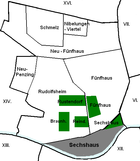Six house
| Six house | |
|---|---|
| coat of arms | map |
 |

|
Sechshaus is the southernmost part of Vienna's 15th district Rudolfsheim-Fünfhaus and one of the 89 Viennese cadastral communities .
geography
The northern border of Sechshaus forms the Sechshauser Straße (called Sechshauser Hauptstraße until 1894), the southern border the Wien River . The area is characterized by relatively close development along the historical, irregular street grid and very few green spaces. The cadastral community extends over an area of 36.24 hectares .
history

After almost all places in the area of today's 15th district had been destroyed during the second Turkish siege in 1683, five villages were created, partly through reconstruction of the old settlements: Rustendorf , Braunhirschen , Reindorf , Sechshaus and Fünfhaus . Sechshaus was built on parts of Meinhartsdorf, which was finally destroyed during the first Turkish siege in 1529. At the beginning it consisted of only five houses at the western growth tip of Gumpendorfer Straße (today 6th district), which was separated from Gumpendorf by the line wall built in 1704 . After the construction of another house, the name Sechshaus became common. Around 1706 a row settlement was built between Sechshauser Straße and Ullmannstraße.
The location on the unregulated Vienna River, which had the so-called Mühlarm here, favored the settlement of craftsmen and manufacturers who needed water for their operations (e.g. dye works) in the 18th and early 19th centuries. In 1830, Sechshaus had 134 houses. The village retained its commercial and industrial character until 1848.
Until 1890, Sechshaus was the official seat of the Sechshaus judicial district, which in addition to Sechshaus included the communities of Fünfhaus, Rudolfsheim , Gaudenzdorf , Ober- and Untermeidling and in 1873 had around 100,000 inhabitants. The place also gave its name to the political district of Sechshaus , which existed from 1868 to 1891.
As of January 1, 1892, many suburbs of Vienna were incorporated beyond the line wall. In the course of this, Sechshaus was constituted with Rudolfsheim to form the 14th district, Rudolfsheim. During the Nazi era , the previous 14th district was integrated into the 15th district of Vienna, Fünfhaus, on October 15, 1938, to free up district number 14 for Penzing, which was separated from the 13th district . At that time, the small district of Neu-Penzing (16 blocks west of Johnstrasse), previously the 13th district, was transferred to the 15th district. In 1957 the district name Rudolfsheim-Fünfhaus was decided.
Building 15., Sparkassaplatz 4 (also: Rauchfangkehrergasse 1 and Ullmannstraße 44), a striking corner building with a dome, was built as a parish hall at the instigation of Josef Ullmann (1846–1890), Mayor of Sechshaus, in 1884/85 according to plans by Eugen Sehnal ( 1851–1910), whereby the rooms on the ground floor of the Sparcasse founded in 1881 remained dedicated to the municipality of Sechshaus . In 1892 this became part of the Wiener Kommunalsparkasse (which was merged into the Zentralsparkasse of the municipality of Vienna in 1923; now: Unicredit Bank Austria ). Between 1970 and 1972 the basement or ground floor was newly adapted for banking purposes by Johann Georg Gsteu (1927–2013).
The line wall was removed from 1894 and the Gürtelstrasse, which had been built since the 1970s, was completed or expanded. The part of the street leading past Sechshaus was called Mariahilfer Gürtel from 1864 to 1869; In 1894 the section from Sechshauser Strasse to Linken Wienzeile was renamed to Sechshauser Gürtel. In 1895–1899, the Vienna River was regulated and provided with a walled river bed. Since 1898, the belt line of the Stadtbahn (since 1989: U6 ) has crossed the southernmost part of this belt section diagonally to the street network on the striking bridge over the Wienzeile, which has become a part of the architectural history of Vienna, based on a design by Otto Wagner .
coat of arms
The coat of arms of Sechshaus shows a scene of the Archangel Michael killing a dragon. Michael wears a silver robe and breastplate. In his right hand he carries a sword with which he kills a fire-breathing dragon, in his left he holds a golden shield.
The coat of arms stems from the fact that the Barnabite College of St. Michael in Vienna was the landlord of the Fünfhaus and Sechshaus settlements.
Personalities
- Friedrich Graumann (1782–1856), textile manufacturer
- Paula Wessely (1907–2000), actress
literature
- Michael Hahn: The district of Sechshaus: a description of the localities Braunhirschen, Fünfhaus, Gaudenzdorf, Ober- u. Untermeidling with Wilhelmsdorf, then Reindorf, Rustendorf and Sechshaus in historical, topographical, statistical, commercial and industrial relationships . Ullrich, Vienna 1853. - Full text online .
- Six house . In: Peter Smöch (Ed.): House scheme of the imperial capital and residence city of Vienna with its ten districts and the suburbs (...) Sechshaus (...) . (Second edition). Zamarski, Vienna 1877, p. 107 f. - online .
Web links
- The history of the 15th district on the website of wien.at
- District Museum Rudolfsheim-Fünfhaus - coat of arms and district history of Rudolfsheim-Fünfhaus
Individual evidence
- ^ Felix Czeike (Ed.): Historisches Lexikon Wien . Volume 5, Kremayr & Scheriau, Vienna 1997, ISBN 3-218-00547-7 , p. 189.
- ^ The new town hall in Sechshaus. In: Morgen-Post , No. 146/1885 (XXXVth year), May 29, 1885, pp. 1 and 3 . (Online at ANNO ). .
- ^ Sparkassaplatz in the Vienna History Wiki of the City of Vienna
Coordinates: 48 ° 11 ′ 11 ″ N , 16 ° 19 ′ 54 ″ E
